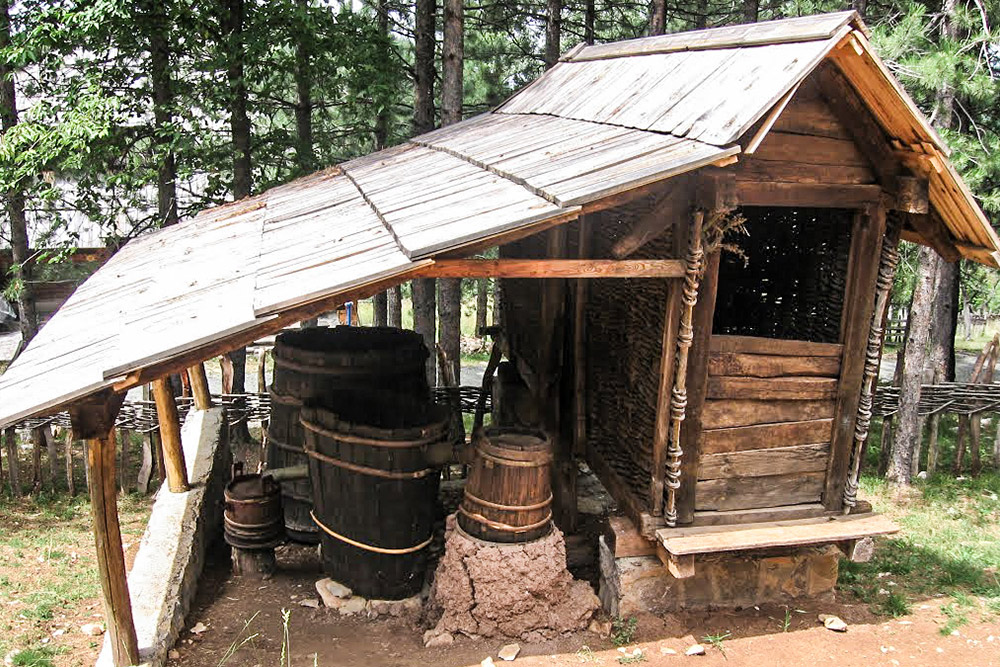
Sirogojno Village
Sirogojno is one of the most attractive destinations of the region, offering a unique open-air museum, or “ethno-village” known as the Old Village Museum with authentic elements of traditional life collected from all over the Zlatibor region from the 19th century.
Village Sirogojno is the only open air museum in Serbia “Staro Selo”. Works on the construction of this museum started in 1979 on a 5 hectare location beside the churches of St. Peter and Paul. Old log houses were brought from all parts of Zlatibor here to be showcased and preserved.
The museum has two parts to it, with the first being a group of houses which have kept the initial look and purpose and they make a museum display formed into two Zlatibor farmsteads. The second is a group of houses that have been preserved according to their original look but their purpose has been changed with them being adapted to cater to the needs of tourists. This includes a hall, a souvenir shop, an inn, apartment building to name a few.
Households
As mentioned, the two Zlatibor farmsteads in the permanent museum display are a testimony of the living culture in the Zlatibor region depicting the end of 19th century into the beginning of 20th century. The way of life in these houses was very specific as they lived in extended family groups (cooperatives) with up to 50 members. The museum has been made of Zlatibor log cabins that belonged to the Dinara type log cabins. Farmsteads were always built on the slope and were turned so as to face towards the sun. The houses were square in shape, the walls were made of level water surface logs bound in “ćetr” (four) in the corners. The roofs were covered with shingle, stone tiles or straw. On the roof there were openings “bađže” for air circulation and on the very top of the roof was a chimney called “kapić”. Characteristically it was normal for Zlatibor farmsteads to have a great number of support buildings all around “the main house”.
Buildings
The central part of the farmstead belonged to “the main house” (it was the highest object in the household). The main house had two rooms-“the house” and “the room” with there being a cellar under the room. On this log house were two doors, the eastern and the western, which apart from being designed for function also had a symbolic meaning. All that was good and beautiful entered the eastern door, the new born baby, the bride,the godfather, guests…, and all that was bad left the house through the western door, the diseased person, garbage ect… An open fire place occupied the central part of “the house”. The fire was used for food preparation and in the evenings members of the cooperative (big family) used to gather together making plans for next day’s before finally sleeping around the fireplace. The house was a room without floor or ceiling except for the “floor” above the fireplace that was used to preserve fire and prevent the smoke from going directly into the meat hanging and drying under “rogovi” (the horns). “The room” used to be little higher than“the house” and it had a wooden floor and a ceiling. There was only one bed which was reserved for the oldest members of the family with the babies born during winter period warmly resting in cradles.
Vajat
“Vajat” was a building used as a sleeping quarters for newlyweds and was given to each of the sons of the master of the farm upon him entering into marriage. These houses were furnished very modestly consisting of one bed, later chests for clothes were added, “lenke” – poles to hang up clothing and bed linen and even later a loom for weaving. In these houses there was no fire. If smoke was seen through the chimney of the “vajat” it meant that the son had separated from his father. In one household, the number of “vajats” depended on the number of married sons of the family head.
Dairy
Dairy was a means for production through the processing and keeping of milk and milk products. Within the family one woman was appointed to take care of the milk as well as processing. She was called “planinka” and she only was allowed to enter the dairy for these reasons. It was a small building with shelves on the walls where wooden troughs, buckets and tubs were kept.
The Bakery
The bakery was beside the house and bread was baked for the whole family supplying enough for their needs for several days.
Kucer
Within the permanent museum display is a shepherd’s dwelling, a special part of a household built in the mountain. It included a hut, a pen and “kućer”. A hut is a small log house built large enough to make fire within it and keep milk products while staying on the mountain. It also included a “kućer” which is a movable bed on a sledge enabling shepherds to always be near their animals.
Housing
In the Museum inn visitors can be served with Zlatibor specialty dishes, prepared in the ancient ways. Part of the Museum programme is to preserve old trades so there are cooper’s, blacksmith’s and potter’s workshops which are equipped, during summer lectures are organized together with the demonstration of handcrafts.
St Peter and Paul’s church
St Peter and Paul’s church was built in 1764 through its founder Georgije Smiljanić of a famous clergyman family that produced 16 generations of priests. The Church represents great value to the iconostas, the work of Simeon Lazović also from the year 1764. Originally it was a wooden structure alone but in the middle of 20th century it was walled in and a two store bell tower was added to it. The church forms part of the open air museum today.


